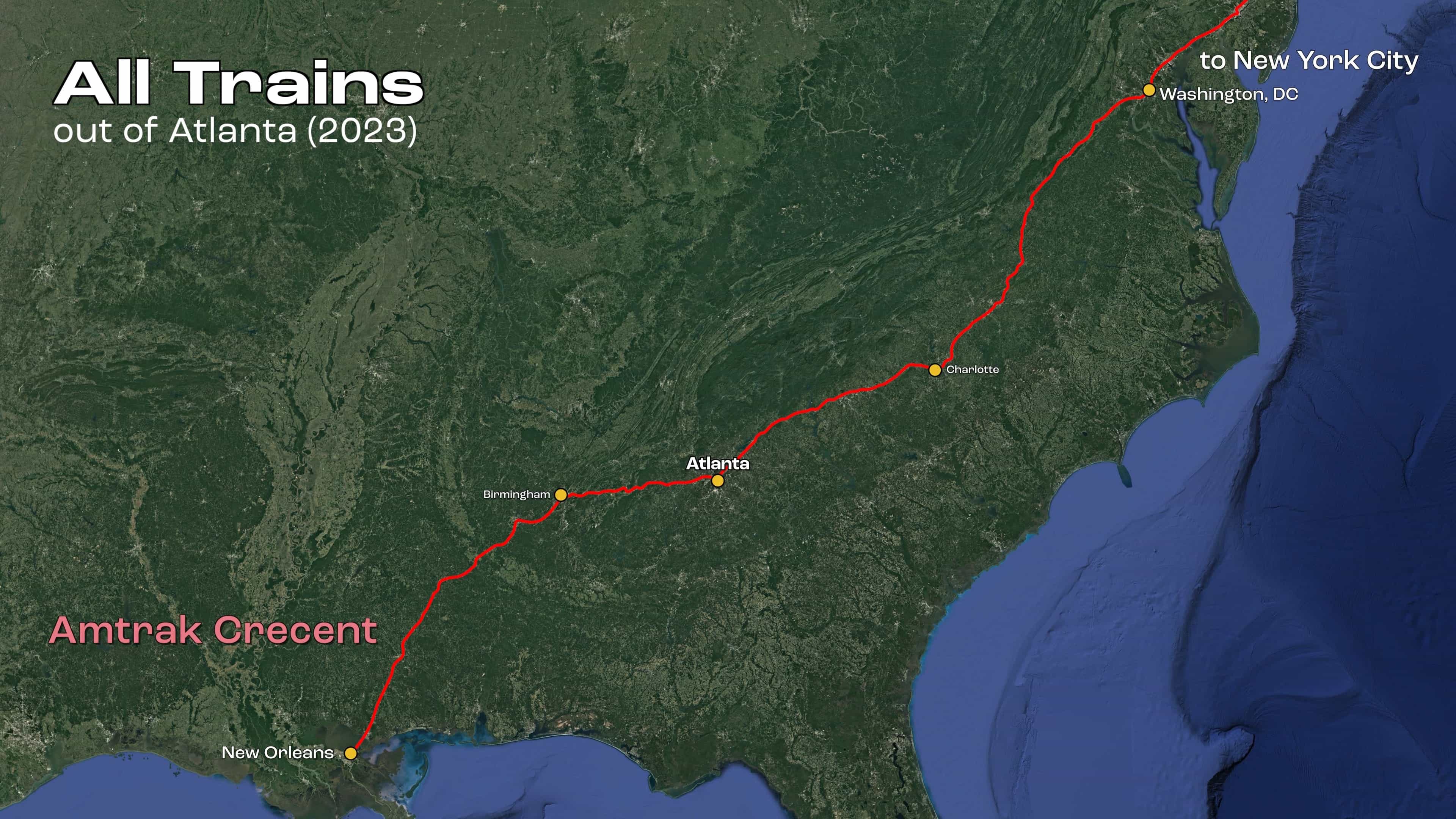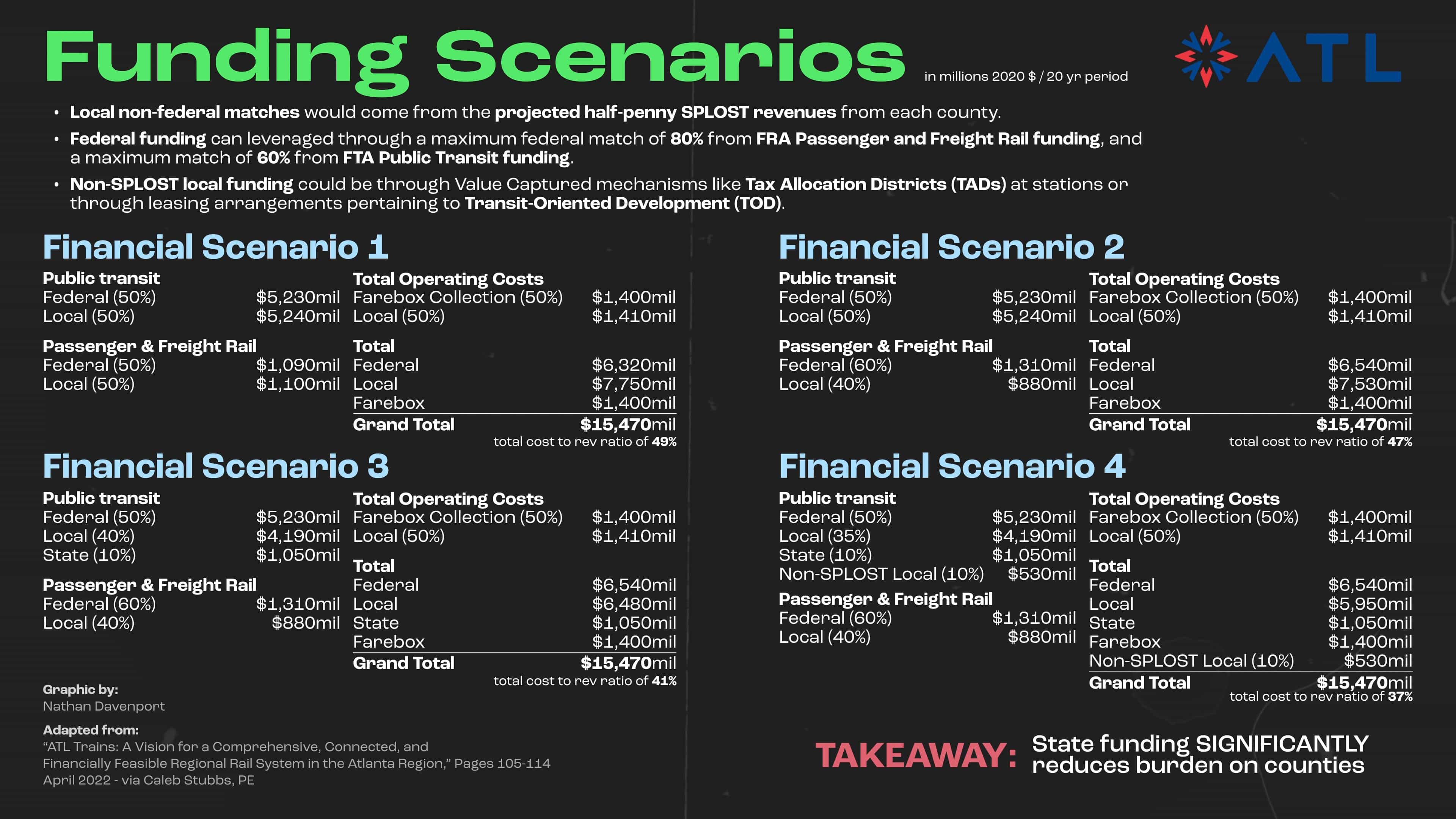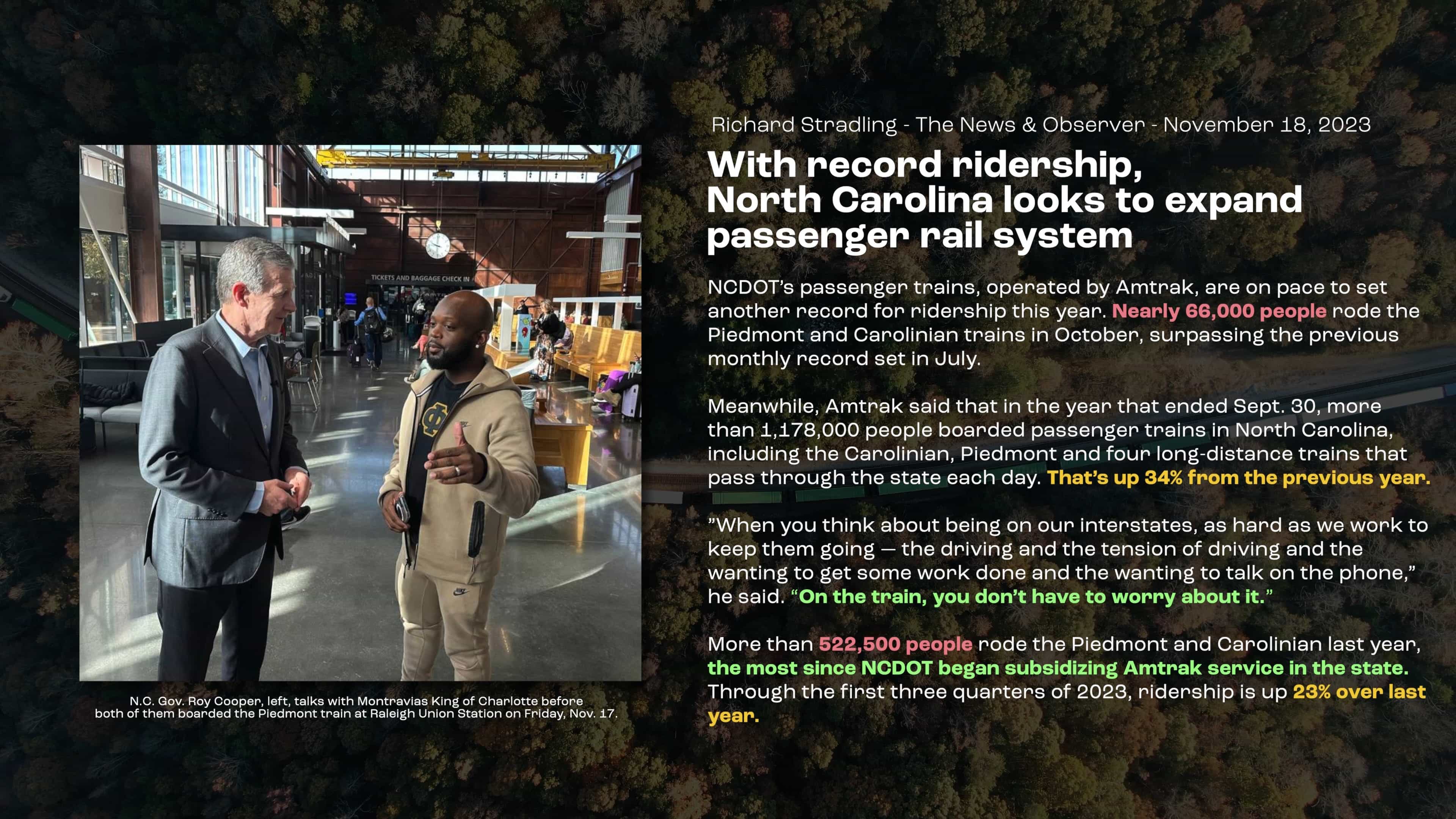Is it time to bring passenger rail back to Atlanta?
Diving into the historical demise of passenger rail in the US, and examining a regional rail proposal for the Atlanta Metro by Caleb Stubbs, ATL Trains.
Published
Written by
Nathan Davenport

What happened to passenger rail?
Remember when you could get anywhere by train? I certainly don’t — Atlanta was once the passenger rail capital of the South, with multiple major stations and hundreds of trains running each day.
But now, this is all that’s left. This weird, tiny station three miles north of Downtown, wedged between the interstate and a Freemason’s Temple.

And unfortunately, it only serves one train a day in each direction, between New York and New Orleans.

It’s strange right? Most of the regions town centers originate from these railroads, but now the tracks are simply tourist attractions.
Luckily, today I’ve partnered with the transit planner behind ATL Trains, Caleb Stubbs, who proposes a revolutionary approach to regional rail for the region. We could transform the way people move in the region, for much cheaper than existing proposals.

So let’s find out, what happened to Atlanta’s passenger rail, and is it time we brought it back?
The glory days
Getting into the history of railroads, I was astounded by all these details that floated around online. This was a much bigger rabbit hole than I thought it'd be! So let’s hop right in.
Atlanta’s tracked riverbed

Most cities spring up around major waterways like rivers and harbors, which allow for places of trade, transportation, and obviously water. Downtown Atlanta is located about five miles Southeast from the Chattahoochee River. But this river is historically not very useful: it’s unsuitable for trade and travel due to its shallow nature this far upstream.

Instead of waterways, Atlanta’s railroads served this purpose, and the city grew around, and eventually up and over the train tracks, embedding the railroads into every aspect of the region’s development. In fact, the city’s original name was “Terminus,” a name representing its importance as the South’s premiere railroad hub.
 Image: via [Thread ATL](https://www.threadatl.org/2018/10/26/the-railroad-gulch-is-atlantas-dry-riverbed/)](/assets/video/passenger-rail-atlanta/2F260e1298-3a89-4809-96a5-ad48a21d8ceb_3840x2160.png)
via Thread ATL
The railroads were the waterway for the city, providing commerce, transportation, and the place where they converged in the heart of Atlanta eventually came to bear a nickname akin to a river, the “ Railroad Gulch. ”
The impressive coverage of American passenger rail
And boy, did people ride trains back then. At the height of passenger rail in Atlanta, it was amazing where you could go by train by the 1920s.
By the early 1900s, Atlanta’s railroad network had expanded from its original 4 corridors to 12 branching out of Downtown Atlanta.
In its heyday, you would see nearly 120 passenger trains coming into Atlanta every single day from places all across Georgia, the Southeast, and the entire Eastern half of the United States.

One prime example is my hometown of Marietta, Georgia. This town completely exists due to the passenger rail stop.
In fact, most of the regions current OTP cities are built along the railroads, their downtown districts right next to some of the 100 passenger rail stations littered around the Metro Atlanta region.
With 90 regional rail-like local trains per day , you could get to most of the regions smaller cities throughout metro Atlanta.

But even more astounding was the sheer amount of long-distance intercity options.
A century ago, there were nearly 30 long distance passenger trains per day , connecting to cities across the eastern United States.
Tragically, today we currently only have one intercity train per day in Metro Atlanta, the Crescent, passing through Atlanta between New York City and New Orleans.

The life and death
The death of Atlanta’s train stations
Behind me, across the street from todays Five Points MARTA station, used to stand Atlanta’s first passenger train station: Atlanta Union Station. Dating back to 1853, the station served 30-40 trains a day at its peak.

via Atlanta History Center, courtesy of Caleb Stubbs (@cest524) of ATL Trains
And here, used to stand one of Atlanta’s grand train stations, Atlanta Terminal Station , built in 1905. At its peak, it served over 90 trains a day , but now stands the Richard B. Russell Federal Building , serving 0 trains a day.

via Atlanta History Center, courtesy of Caleb Stubbs (@cest524) of ATL Trains
Both were beautiful historic buildings, that were demolished in 1972.
 Image: via [Google Maps Streetview](https://maps.app.goo.gl/4WV71TKwFFEW2fen9?g_st=i)](/assets/video/passenger-rail-atlanta/2F52f260ea-6230-4003-8e12-8320a9a5d44f_3840x2160.png)
Regulation
So what led to the rapid decline of railroading during this period? Well, after some research, it surprised me how it really went down.
The demise of US passenger rail by the 1970s was a long, winding road that largely tracks with the rise of the automobile and airline industries.
While technically private companies, railroads were the first industry in US history to be regulated by the federal government , which they did from 1887 all the way to 1980.
Up until the 1920s, while freight was the railroad companies bread and butter, passenger rail was profitable to the railroads because it really was the premiere way to travel, and there was really no competition.
Unfair subsidization of cars and planes
Local passenger trains were the first to fall out of favor to the American public as more Americans bought cars like the Model T Ford and decided to drive those routes instead.
There was a short lived resurgence in mid-40s because of gas rations during World War II, but of course that did not last and they mostly disappeared by 1950.
Long distance trains stuck around a few years longer, driven by massive federal investment in sleek streamliners after the war, but by the 1960s, they too had fallen out of favor due to the rise of passenger jets and airports.
Passenger rail ticket prices increased rapidly due to the decreased demand, and after World War 2, the deteriorating railway infrastructure across the US made it difficult for railways to modernize train travel and compete with the airplane and interstate highways.
It wasn’t just limited to passenger trains either. During the post-World War II boom, many railroads went bankrupt and were driven out of business by tight regulations and competition from airlines, cars, and the burgeoning trucking industry.
The nail in the coffin was the National Interstate and Defense Highways Act of 1956, which practically killed passenger rail for Americans, as passenger and freight rail companies just couldn’t compete with cheap cars, cheap gas, and fast new expressways that started being constructed across the US over the second half of the century.
Between an 18-year span following the year after World War II, 1946, passenger traffic declined from 770 million to 298 million by 1964. - Adam Burns, Decline of Railroads
Nationalization of the railroads
Eventually, most rail companies would go bankrupt, as regulation made it much more difficult for the railroads to compete. In response, President Nixon nationalized the passenger rail industry through the Rail Passenger Service Act, and nationalized the industry into Amtrak on May 1, 1971, in order to take the burden of passenger services off of the freight companies.
The federal government consolidated all of the bankrupting northeastern freight companies into Conrail, and eventually, deregulated the railroads by 1980, through the Staggers Act.
Unfortunately, it was really too late for the railroads. American's fell in love with the car, and by this time interstate highways and air travel made these transportation modes way more convenient for most Americans.
So by 1970, with Atlanta’s formerly illustrious passenger rail stations now being closed, Atlanta’s railroad gulch "dried up," and became increasingly less useful, and more so disruptive and unattractive.
Rebirth
Luckily, in recent years we’ve seen a major insurgence of interest in train travel.
Amtrak ConnectsUS Program and Corridor ID
As a result of the Biden Administration’s Bipartisan Infrastructure Law passed in 2021, five-year funding for transit expansion went up to $39 billion, while funding for passenger and freight rail went up to $66 billion over the next five years.

This is huge because, this is the first time the federal government has made a meaningful investment in a comprehensive, nation wide rail expansion plan.
Atlanta is seeing money to fund Amtrak routes from Memphis, through Nashville and Chattanooga, continuing on to Savannah. Additionally, funding for a high speed rail route through Athens to Charlotte was funded as well through the Corridor ID program.

Now, it’s important to note that this funding isn’t putting any shovels in the ground. This is strictly money for planning and study efforts. But, it is exciting to see federal investment in the Atlanta region.
ATL Trains, a transformative regional rail proposal
Which means, theres a easy opportunity to revolutionize transportation here in Atlanta, all without resorting to grifting tech bro solutions!
For this video, I’m excited to partner with Caleb Stubbs , a transit planner who has spent the past four years crafting an innovative regional rail transit solution for Metro Atlanta, ATL Trains.
With a 145 page white paper, the concept has generated a lot of buzz among transit nerds here in the region.
Vision
He proposes a 300-mile regional rail system that would transform the region by leveraging the railroad infrastructure we already have, investing in and expanding it to optimize the regional movement of both people and freight.
The ATL Trains Vision is all about implementing all-day, bidirectional regional rail service serving the estimated 82 percent of the Region’s existing activity centers that lie within a half-mile of a railroad corridor.

Since building new tracks on existing corridors slashes capital costs by upwards of 80 percent that of building a brand new corridor from scratch, regional rail offers all the proven benefits of conventional rail transit for a cost comparable to BRT.
He proposes 90 stations along 11 regional rail lines that converge onto a so called Central Corridor through Downtown Atlanta, Atlanta’s Westside, and to the Atlanta Airport; the same corridor that brought in 120 passenger trains per day into Atlanta one century ago.

The plan would connect 12 counties with proper rail services, and since most town centers already exist on historic rail lines, it would revitalize downtowns across the region, while complimenting the existing public transportation networks of MARTA, CobbLinc, Ride Gwinnett, and more.

Most importantly, is the restoration of a downtown train station, located right here in the Gulch, right where Atlanta’s historic downtown stations once stood, potentially within the Centennial Yards project, or through adaptive reuse of CNN Center. This station could serve as a regional hub for the entire South East, and allow for easy transfers to Amtrak, MARTA Rail, streetcar, and bus services.
 Image: via [ATL Trains whitepaper](https://drive.google.com/file/d/1uh-G-IGc3rLCm98qPzx9rIRkloyl-aNM/view?usp=sharing)](/assets/video/passenger-rail-atlanta/2F5ddd914a-7ca1-4b54-9993-77733a8c988f_3840x2160.png)
Funding
What’s really interesting about this proposal though, is that economically, it could be quite financially feasible with the right political support.
By leveraging and expanding existing railroad corridors over assembling brand new ones, The ATL Trains Vision offers an upfront cost savings of upwards of 80% per mile compared to expanding the existing MARTA rail system, while being capable of providing competitive levels of service. Additionally, minimal right of way would be needed since it would stay almost entirely within existing freight rights of way.

In theory, the 13 counties could fund the project with a half-penny (0.5%), 30-year HB 930 Transit SPLOST tax, and would use the Atlanta Region Transit Link Authority, the ATL, as its operator.

This circumnavigates constitutional roadblocks that come with using authorities such as MARTA as it's operator, and enables greater flexibility in funding sources.

Roadblocks
The biggest roadblock in general rail investment here in Atlanta is the freight railroads, and the state government.
For example, Clayton County recently joined MARTA, Atlanta’s transit authority, and promised regional rail service throughout the county to connect into the MARTA system.

However, due to lack of compliance with the freight rail companies, Clayton County and MARTA were unable to reach any sort of agreement to do the project. Now, MARTA is proposing “Bus Rapid Transit” for the county, and honestly its a bit of a laughable project looking at it. The route just doesn’t make sense for BRT, and while some bus lanes will help the route, its so winding and not at all what MARTA promised Clayton County.

Historically, the best chance of working with the freight railroads is is through the state government. But, the Georgia state DOT has never been very supportive of transit in the region.
This is because Georgia DOT is constitutionally prohibited for state gas tax revenues to fund anything but roads, and therefore, Georgia DOT has never given a cent to MARTA in its lifetime.

People often ask why MARTA "sucks," but really, it was set up from the beginning to struggle, and lacking state support makes it really difficult to build regional projects that compare to other states in the country, as we pretty much always need federal funding.

Concluding
Freight collaboration
The key here is that passenger rail investment can be a win-win for both freight and passenger services.
Often, politicians make out that passenger services impede on freight operations, however, this simply isn't the case. ATL Trains details how investment benefits both parties -- through dramatically expanding capacity, eliminating bottlenecks, improving network fluidity, and more.
 Image: via [ATL Trains whitepaper](https://drive.google.com/file/d/1uh-G-IGc3rLCm98qPzx9rIRkloyl-aNM/view?usp=sharing)](/assets/video/passenger-rail-atlanta/2Fde6c16b0-8268-40b0-b728-92507bf216e0_3840x2160.png)
Setting the example
Nearby states such as North Carolina are taking rail expansion seriously, and since their state DOT has invested in improving Amtrak service through the NC By Train program, they've seen intercity ridership increase 23% since 2022 , **** and have many improvements in the pipeline.
_ Image: _via[The News & Observer](https://www.newsobserver.com/news/local/article281987988.html)_](/assets/video/passenger-rail-atlanta/2Fc25a3ddb-497a-43fb-827f-64eabc7f5428_1548x792.png)
They face the exact same challenges we do here in Georgia - gaining state support, and working with the freight companies. They're doing exactly what ATL Trains proposes: improving rail operations for both passenger and freight.

States like North Carolina, Florida, and Virginia are taking rail expansion seriously. As Caleb details in the ATL Trains white paper, when done right, rail investment can be a great opportunity to improve operations for freight railways as well.
The project proposes multitudes of capacity enchantments and junction reconfigurations to improve through flow and overall improve operations, to both to run passenger trains and improve freight operations significantly.
Closing
I urge everyone watching to checkout atltrains.com, and even read the full white paper on the proposal, as it would be game changing for the region.
Let me know what y'all think of the ATL trains plan, and thanks again to Caleb Stubbs for working with me on this! Thanks y'all for watching, see you next time.
Get involved
- Checkout the ATL Trains website at atltrains.com
- Read the white paper (it’s a long one!)
- Sierra Club also has a great initiative called the Get On Board Georgia Initiative
- Amtrak’s recently released Cooridor ID listing
References
-
Morrison, Jeff. "The Railroad Gulch: Atlanta's Dry Riverbed." ThreadATL, 26 Oct. 2018, https://www.threadatl.org/2018/10/26/the-railroad-gulch-is-atlantas-dry-riverbed/.
-
Stubbs, Caleb. "ATL Trains - Our Passenger Rail History." ArcGIS StoryMaps, Esri, updated 13 Sept. 2023, accessed 10 Dec. 2023, https://storymaps.arcgis.com/stories/e830c5581fd04ee1bb55c6beabecdc07.
-
Stubbs, Caleb. "ATL Trains - Our Passenger Rail History." ArcGIS StoryMaps, Esri, updated 13 Sept. 2023, accessed 10 Dec. 2023, https://storymaps.arcgis.com/stories/e830c5581fd04ee1bb55c6beabecdc07.
-
Burns, Adam. "Decline of Railroads." American Rails, last revised 7 May 2023, https://www.american-rails.com/decline.html.
-
Burns, Adam. "Decline of Railroads." American Rails, last revised 7 May 2023, https://www.american-rails.com/decline.html.
-
National Association of Counties. "Legislative Analysis: Counties & Bipartisan Infrastructure Law." National Association of Counties, 4 Mar. 2022, www.naco.org/resources/legislative-analysis-counties-bipartisan-infrastructure-law.
-
McKinsey & Company. "The US Bipartisan Infrastructure Law: Breaking It Down." McKinsey & Company, 12 Nov. 2021, www.mckinsey.com/industries/public-sector/our-insights/the-us-bipartisan-infrastructure-law-breaking-it-down.
-
Green, Josh. "MARTA, Clayton County Transit, Airport Link Move Forward." Urbanize Atlanta, 12 Dec. 2023, https://atlanta.urbanize.city/post/MARTA-clayton-county-transit-airport-link-move-forward.
-
Short, Aaron. "Atlanta’s Transit Flaws Are State’s Fault." Streetsblog USA, 25 Sept. 2019, https://usa.streetsblog.org/2019/09/25/atlantas-transit-flaws-are-states-fault.
-
Stradling, Richard. "With Record Ridership, North Carolina Looks to Expand Passenger Rail System." The News & Observer, 18 Nov. 2023, www.newsobserver.com/news/local/article281987988.html.